
Call Us +62 361 9000401
Jl. Raya Kelabang-Moding, Kelabang-ModingUbud, Gianyar, Bali 80571 - Indonesia info@bidadarivillasubudbali.com

Jl. Raya Kelabang-Moding, Kelabang-ModingUbud, Gianyar, Bali 80571 - Indonesia info@bidadarivillasubudbali.com
Discover this mystical village called Ubud and find out why it is special in more ways than one.
Only 4kl from Bidadari Private Villas & Retreat, It has its own magic, and its particularly beautiful surroundings and gracious way of life have drawn celebrities and artists from all over the world in recent decades; some have even adopted Ubud as their own home.
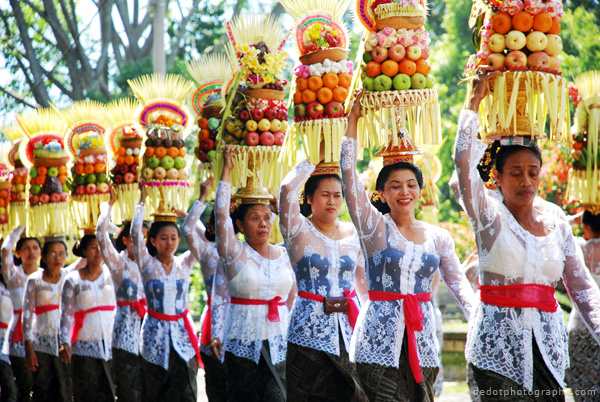
Ubud is now more than ever in the spotlight due to the famed book by Elizabeth Gilbert and movie “Eat Pray Love”. If I have to describe Ubud Bali in one word I would say “mystical village”. Despite the large numbers of tourists visiting this little village with streets that are too narrow for touring buses, Ubud has been able to maintain its traditional life.
discover-mystical-village It is the meditation capital of Bali, many people come here purely to recharge their batteries from the past paced western life, here you just surrender to the energies and let go.
Ubud has been voted the 6th best city in Asia in October 2012 by the Condé Nast Traveler, it is not hard to see why; everywhere you look is paradise with dense green jungles, myriads of rice fields and beautiful tropical gardens.
Here Balinese men and women still place offerings gracefully on the side of the road and on temples; every day you will see them riding beautifully dressed on motor scooters to temples and ceremonies while holding colourful woven baskets, sometimes you can witness even up to four on a bike.
This is not a village were you should be up and running…the order of the day is to RELAX and live in the NOW. It is more a place where you’ll want to stroll around or just sit with a book and watch the colourful and delightful pictures pass by.
If you can’t resist some action though, there is the Monkey Forest where you’ll be greeted by the many Macaque monkeys. There is also the Ubud Market. This market starts off early in the morning as a food market by 11.00 am it is a maze of shops that sell everything a traveler in Bali can imagine…and more.
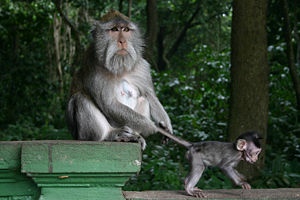
In Ubud and its surrounding hamlets cultural influences and artifacts are still found. Besides absorbing the cultural beauty of Ubud there are many other things to do which always seem to be intertwined with the daily village life. For instance the nearby temples show you the historical and religious influences that are still present today while the many museums offer you the opportunity to learn about their Bali paintings, drawings, carvings and statues. Besides this you can also actively learn about the village’s culture by participating in dance, paint, mask-making and cooking classes, for which you will do some shopping at the local market. These courses are pretty exceptional for Bali and the tourism foundation of Ubud Bali encourage this as this is one of the ways to create a balance between tourism and the locals. Only through this balance can the natural and cultural beauty of the village be preserved. The stunning location of the village also provides enough opportunity to explore the rice terraces or the river valleys that are found in and around the village. When walking through the panoramic scenery you will find yourself up close with the local people who are working in the fields throughout the day. But remember once you are there, take your time and just experience it, The village is surrounded by fertile land which has resulted in the beautiful rice field terraces you always find in travel and photo books on Bali. This is also an ideal location to explore the terraces yourself and take beautiful pictures while standing in the midst of it all and feeling part of it.
Discover_mystical_village_Ubud_From here an unique place has emerged into a painter’s village that has attracted many people, including foreigners who have played their part in forming various painting styles. It is not surprising to see that many artists feel at home in this village considering the mystical and inspiring setting. Today painting still plays an important role in Ubud and around. There are many galleries where painters sell their work. Additionally there are several important art museums that show unique paintings that will create even more appreciation for this form of art.
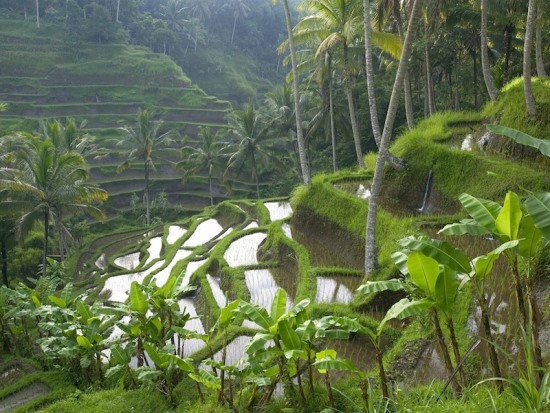
You can continue your cultural adventure in the evening where you can choose from many Balinese performances such as the graceful Legong dance, the cool-looking Kecak-trance dance and the Jegog with its amazing sound created by playing the giant Bamboo, also the funny Wayang Kulit shadow puppet plays. This is a great way to end your cultural day experience in Ubud Bali followed by a cocktail, glass of wine or a local Bintang in one of the many garden restaurants.
You can continue your cultural adventure in the evening where you can choose from many Balinese performances such as the graceful Legong dance, the cool-looking Kecak-trance dance and the Jegog with its amazing sound created by playing the giant Bamboo, also the funny Wayang Kulit shadow puppet plays. This is a great way to end your cultural day experience in Ubud Bali followed by a cocktail, glass of wine or a local Bintang in one of the many garden restaurants.
Ubud is an ideal place to walk around, especially if you check out the small streets and alleys on the side of every road. They lead you to amazing places such as rice fields, river valleys, temples and Balinese living court yards. Ubud Bali has three big main roads which are all one way-streets. So you will definitely drive through them regularly if you are finding your way through Ubud by car, bike or motor scooter. The busiest and one of the longest is the Monkey Forest Road. This road starts in the south when you come into Ubud and ends all the way in the north at the crowded Ubud Market. This street is overdeveloped with shops, restaurants and places to stay. Monkey Forest road already looks cramped, but there is even more behind the many buildings along this road. The many alleys (gang) on both sides of the road are passages to tucked away hotels (many cheap homestays), spas and restaurants. Jalan Raya (the Royal Rd) is a road that crosses Monkey Forest Road in the center of Ubud Bali. To the left, this road leads you to the Campuhan area.
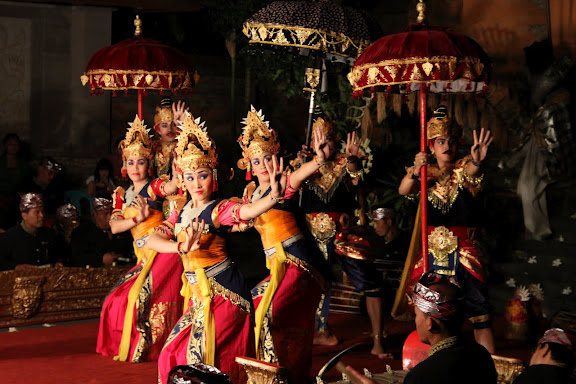
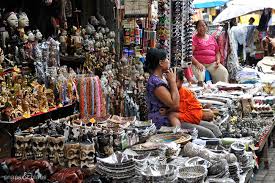
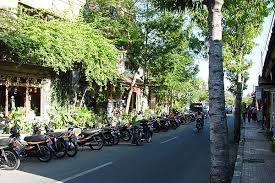
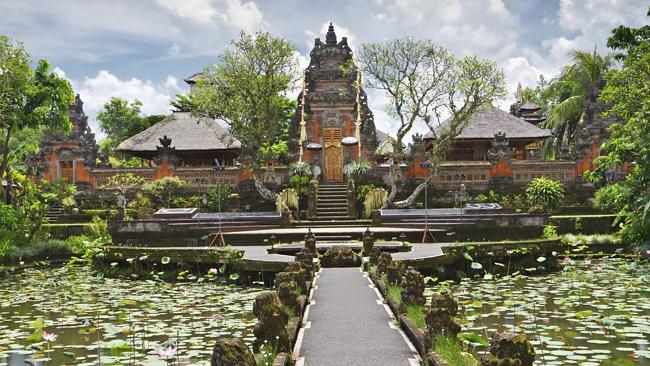
Within these sacred grounds you can start a rice field walk that goes on further north of Ubud past the ancient-looking villa complex Ibah. Another road that you’ll certainly come across is Jalan Hanoman. Like Monkey Forest Road, this street is long and it has many shops, restaurants, hotels and homestays. Going towards Monkey Forest Rd, Jalan Hanoman comes to a fork, the right vias off to Monkey Forest Rd, whilst to the left is still Jalan Hanoman and goes on passing the ARMA museum then becomes Jalan Raya Pengosekan that takes you on to Lutundoh village.
Ubud is relatively small so if you have the time you can easily walk around and see a lot. The streets and footpaths are a little bumpy, occasionally you might find a hole or two or a loose pavementso be careful (Hati Hati) of your footing. However look out for the colourful offerings which are placed along the streets and in front of shops.
Along Monkey Forest Road there are many bicycle and motor scooter rentals, usually the price drops the longer you rent them. Before you hop on, check the profile of the tyres are still good. It can get really slippery when it rains. An accident is the last thing you need during your well-deserved holidays… Everywhere in town you will find many private drivers sitting in the shade of a tree only to jump up when you come in sight. Instantly they will make this driving movement with their hands and at the same time wiggle a little with their body. ‘Transportation…?’ is the first thing they say. If you reply with: ‘No thank you…’ or ‘Tidak Teramikasi’ (pronounced as ‘tear out my car seat’), you can immediately expect the next question ‘How about tomorrow…yes?’ They are harmless but can get on your nerves after passing dozen of them within minutes. But if you are considering touring around for a day then a private driver is what you need. Check out if you like their car and then bargain for a price that suits you. Monkey_Forest_Bali_Ubud_Villas
The Post Office is located on Jalan Jembawan on the east-side of Jalan Raya. If you don’t feel like walking all the way you can always leave your postcards with the hotels’ concierge service.
The Ubud Clinic, 24H (0361-974911) can be found on the west-side of Jalan Raya before the Campuhan bridge and here bilingual staff is also available.
If you need the Police(0361-975316) you can find them on Jalan Raya Andong in the north-eastern part of Ubud. Turn left at the traffic lights at the end of Jalan Raya near the huge statue.
The Tourist Office is open from 8am-8pm daily and located on the crossing of Jalan Monkey Forest and Jalan Raya, just across the Ubud Palace. Here they can offer you some maps, brochures and the monthly issue of Ubud Community with useful articles and a calendar of events
Ubud is filled with mystical treasures that need to be unveiled, below are some of just a few activities and places to visit.
Ubud is full with all types of restaurants and cafes. After just a couple of meters you will bump into one again. So no chance of getting hungry here… There is a mixed choice of restaurants such as the classy modern looking restaurants, restaurants that only serve organic food and drinks or restaurants that have a gorgeous garden where you can sit on a big pillow on the floor. But there are also the basic ones (but always with some nice decoration) that just offer you what you’re looking for: Good Food.
Below is a list of recommended Restaurants & cafes; it gives you a taste of what you can find in Ubud.
Of course there are far more, too many to mention, you can find relatively cheap cafes in and around Ubud and get a fair proportion of tasty, healthy and above all safe food….just walk around, talk to people and see what takes your fancy.
If you are into shopping, well, look no further, there are so many shops and shopping experiences to be had in Ubud and beyond. Below is a list of shops and comments:
In the eighth century, a Javanese Buddhist Priest, Rsi Marhandya saw a distant light rising from the earth to the sky and returning again. So Rsi organized a large group of men and women to find the place which was the source of the light. On this first journey he found a beautiful island as we know now as Bali. By the time Rsi and the search party eventually reached the mountains they came across Taro (30 minutes from Ubud) where he and his men fell ill and many died, they returned to Java where Rsi had another vison, regrouped his men and set out on his quest again. After a long journey he finally found the place of the light in the central mountains of Bali, Ubud and this time built a sacred temple on the site.
On the journey, Rsi was led to stop and meditate at a place where two rivers met. It was at Campuhan (which actually means two rivers meet) that Rsi Marhandya received the inspiration he needed on how to build what is now one of the most revered and beautiful temples in all the world. He meditated at the confluence of the two Wos Rivers at Campuhan, just west of the modern day town centre.
To mark this place of holy inspiration, a small temple was built on the banks of Campuhan and the surrounding land granted to the royal family of the town near Campuhan and refers to the healing power of this most sacred ground. Ubud means Medicine in Balinese, Ubud was originally called Ubad and was revered as a source of medicinal herbs and plants. Tjokorda Raka of the Ubud Royal family has had a dream of opening up this and sharing the rejuvenating life of this place with visitors of other cultures.
A shrine was established and later expanded by Nirartha, the Javanese priest who is regarded as the founder of Bali’s religious practices and rituals as we know them today. Campuhan has continued to be a source of light and inspiration for many, attracting artists and musicians of worldwide notoriety such as Walter Spies, Rudolf Bonnet, Colin Macphee, and Noel Coward, last but not least in this line was Antonio Blanco.
Further temples and monasteries were established over the next 400 hundred years or so, the ninth century cave temples at Goa Gajah, the famed Elephant Cave (just east and northeast of Ubud), are architectural remains from this period and many of the dances, drama and rituals still practiced in Ubud today, originated at this time. King Airlangga ruled all of Java and Bali in this era, and his seat of government was located in what is now the village of Batuan, just southeast of Ubud.
Another beautiful temple built around this time was Gunung Kawi, an 11th century temple complex in Tampaksiring north east of Ubud in Bali, Indonesia. It is located on the river Pakrisan. The complex comprises 10 rock-cut candi (shrines) carved into the cliff face. They stand in 7m-high (23 ft-high) sheltered niches cut into the sheer cliff face. These monuments are thought to be dedicated to King Anak Wungsu of the Udayana dynasty and his favourite queens.
The Javanese Majapahit kingdom conquered Bali in 1343, and the key final victory was against the Pejeng Dynasty centred at Bedulu, just to the east of Ubud. A great flowering of Balinese culture followed, and the ancestry of Ubud’s current day aristocratic families can be traced back to this period. In the sixteenth Century, there was a total transplantation of the Majapahit Kingdom to Bali as the Islamisation of Java forced them eastwards. Power flip-flopped between various dynasties and feudal lords, but the Ubud area remained a very important cog in the various regencies which ruled the island.
It has been the stamping ground of Bali’s earliest dynasties in recorded history. It is here that the first great lines of Hindu Zed Kings established themselves. Pejeng was the center of power until the early 14th century, when the last line of Warmadewa was defeated by Majapahit Empire, Under Gajah Mada, in 1343. The two rivers, Petanu and Pakrisan, have been storing series of ancient historical remains along the banks, such as temples, meditation cells, baths and other monuments.